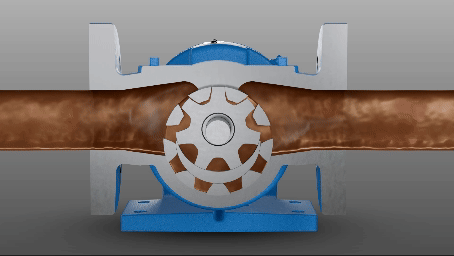Internal Gear Pump

A type of gear pump a drive gear featuring inward facing teeth called a rotor. This rotor turns an offset gear with fewer outward facing teeth called an idler. A crescent shape protruding from the head of the pump creates this offset and seals the pumping cavities formed between the gear teeth. Click here to view our How it Works video on this subject.
What is an internal gear pump?
An internal gear pump is a gear pump featuring a drive gear with inward facing teeth called a rotor. This rotor turns an offset gear with fewer outward facing teeth called an idler. A crescent shape protruding from the head of the pump creates this offset and seals the pumping cavities formed between the gear teeth. Click here to view our How it Works video on this subject.
This pumping principle was invented by Viking Pump over 100 years ago.

How do internal gear pumps work?
The internal gear pump is a rotary positive displacement pump that moves fluid using the rotary motion of the pumping elements. Liquid enters the suction port between the teeth of the rotor gear - the larger exterior gear, and the idler gear - the smaller interior gear. The intermeshing gears of the rotor and idler form locked cavities for the liquid to ensure volume control.

As the teeth come out of mesh, low pressure zones are created at the suction port, pulling liquid into the spaces. The liquid continues to travel through the pump, between the teeth of the gear-within-a-gear principle. Liquid is prevented from returning to the suction side by the crescent located on the head of the pump, acting as a seal between the suction and discharge ports.
When the teeth mesh completely, liquid is forced out of the spaces and out of the discharge port.is rotated by the driver gear.
As the gears come out of mesh, they create an expanding volume on the inlet side of the pump. This creates a vacuum which pulls liquid into the pump. Liquid is trapped between the gear tooth cavities and the close fitting casing wall. The rotation of the gears carries the liquid around to the outlet side of the pump. The liquid does not pass between the gears. At the outlet, the meshing of the gears forces the liquid through the outlet port.

What are internal gear pumps used for?
Internal gear pumps are used in a wide variety of applications because they're suitable for a wide range of viscosities and come in a variety of sizes and constructions. Some of the most common applications include asphalt, adhesives, and chocolate.






